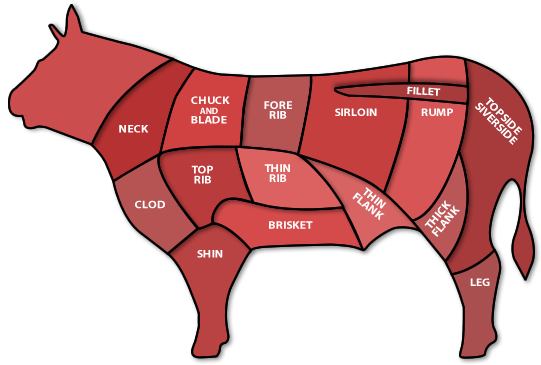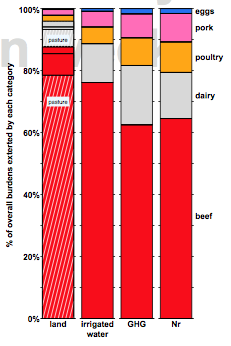The environmental burdens imposed by beef production far exceed the burdens imposed by other types of livestock and plant staples, according to a US study.
Comparing how much feed and therefore land, water and fertiliser was required in US production, dairy, poultry, pork and eggs were quite similar, but beef required 28 times more land, 11 times more water, five times more greenhouse gas emissions, and six times more fertiliser than the others.  Beef production is also a major industry in New Zealand.
Beef production is also a major industry in New Zealand.
According to Beef & Lamb New Zealand, beef cattle numbers were 3.7 million at 30 June 2013 of which 1.0 million were beef breeding cows and heifers. Total beef and veal production for the year to September 2013 was 628,000 tonnes. Around half of beef and veal exports from New Zealand are destined for the US market.
The authors, who published their research in the journal PNAS, concluded: “Our results thus offer policymakers a method for calculating some of the environmental consequences of food policies. Our results can also guide personal dietary choices that can collectively leverage market forces for environmental betterment. Given the broad, categorical disparities apparent in our results, it is clear that policy decisions designed to reduce animal-based food consumption stand to significantly reduce the environmental costs of food production while sustaining a burgeoning populace.”
From the paper: “Livestock-based food production is an important and pervasive way humans impact the environment. It causes about one-fifth of global greenhouse gas emissions, and is the key land user and source of water pollution by nutrient overabundance. It also competes with biodiversity, and promotes species extinctions. Empowering consumers to make choices that mitigate some of these impacts through devising and disseminating numerically sound information is thus a key socioenvironmental priority. Unfortunately, currently available knowledge is incomplete and hampered by reliance on divergent methodologies that afford no general comparison of relative impacts of animal-based products. To overcome these hurdles, we introduce a methodology that facilitates such a comparison. We show that minimizing beef consumption mitigates the environmental costs of diet most effectively.”
Our colleagues at the UK SMC gathered some reaction to the research from UK-based experts.
Prof Ilias Kyriazakis, Head of the Integrated Animal Science Group and an expert on mono gastric livestock production at Newcastle University, comments: “The outcomes of the study are consistent with previous studies that have been conducted in the UK and elsewhere in Europe. Ruminant systems are in general more environmentally impacting than non ruminant ones. The major issue however is what kind of commodity systems are compared, as the choice of systems will almost predefine the outcome of the study and the magnitude of the differences estimated. For example, comparison of an intensive beef system with a low input, organic broiler system will show small differences in the environmental impact of the two systems and vice versa. The Livestock Environmental Assessment and Performance Partnership of the FAO has already identified this issue as a major pitfall in the comparison of the environmental impacts between different agricultural commodities.”
Prof Mark Sutton, Centre for Ecology and Hydrology, comments: 
“The paper by Gidon Eshel and others in PNAS highlights a key message that livestock production – and beef production in particular – contribute to multiple environment problems, including water availability, greenhouse gas emissions and nitrogen pollution.”Their conclusions for the US confirm and extend the our findings for Europe, in the European Nitrogen Assessment (ENA). For example, the ENA estimated nitrogen use efficiency for beef at 5-13% (= N in produce / N in feed * 100), while that for poultry was 25-49% – around 4-5 times higher. Gihon and colleagues for the US go further in highlighting the land, water and greenhouse gas needs for beef, which are around 28, 11, and 5 times higher than for other livestock categories.
“As Gihon et al. recognize, the extremely high land-use needs relate to the fact that beef farming uses lowerquality dry lands for grazing, which are unsuitable for cropping or other feed production. But this point should not be used to underplay the reality that the US and Europe alike are using so much of their land in highly inefficient livestock farming systems, while so much good quality cropland is being used to grow animal feeds rather than human food.”For comparison, the ENA showed that 85% of the plant nitrogen harvested in European goes to feed livestock: only 15% goes to feed people. While society typically thinks of farming’s role being to meet ‘food security’ needs, the reality is one of ‘feed security’. With less meat consumption, a larger fraction of land could really be devoted to meet food security (and energy security) goals.
“The overall environmental footprint of beef is particularly large because it combines a low production efficiency with very high volume. The result is that Gihon et al. estimate that over 60% of the environmental burden of livestock in the US results from beef (their figure 3). Although the exact numbers will be different for Europe (expecting a larger role of dairy), the overall message will be similar: cattle dominate the livestock footprint of both Europe and US.
“European governments should consider these messages carefully if they want to improve overall production efficiency and reduce the environmental impacts. “But the message for the consumer is even stronger. Avoiding excessive meat consumption, especially beef, is good for the environment. One option discussed by the European nitrogen science community is to take a ‘demitarian’ approach, reducing meat intake by half. The recent ENA Special Report ‘Nitrogen on the Table’, showed that such a scenario for the whole of Europe would reduce red meat consumption down from 207% to 107% of the recommended mean daily intake (RMDI) according to the World Cancer Research Program. This suggests opportunities for our personal health as well as for the environment. “Supplement: note that there are further differences between the US (Gihon) and European (ENA) numbers. For example, we found that milk production had the second lowest nitrogen use efficiency, while poultry had the highest efficiency. By comparison, Gihon et al. find that pork have the second lowest efficiency, and eggs have the highest efficiency.
To summarize: “Our ranking in ENA p 7: (best) poultry meat, eggs, pork, milk, beef (worst)”Gihon et al. ranking, Fig 2D: (best) eggs, dairy, poultry meat, pork, beef (worst). “It would take more time to evaluate these details, though as you see the overall messages are consistent with our own work.”
Declarations of interest: Prof Sutton is the co-author of the ENA Special Report “Nitrogen on the Table”